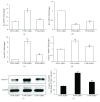Lycium barbarum Polysaccharides Protect Rat Corneal Epithelial Cells against Ultraviolet B-Induced Apoptosis by Attenuating the Mitochondrial Pathway and Inhibiting JNK Phosphorylation
- PMID: 28798932
- PMCID: PMC5536140
- DOI: 10.1155/2017/5806832
Lycium barbarum Polysaccharides Protect Rat Corneal Epithelial Cells against Ultraviolet B-Induced Apoptosis by Attenuating the Mitochondrial Pathway and Inhibiting JNK Phosphorylation
Abstract
Lycium barbarum polysaccharides (LBPs) have been shown to play a key role in protecting the eyes by reducing the apoptosis induced by certain types of damage. However, it is not known whether LBPs can protect damaged corneal cells from apoptosis. Moreover, no reports have focused on the role of LBPs in guarding against ultraviolet B- (UVB-) induced apoptosis. The present study aimed to investigate the protective effect and underlying mechanism of LBPs against UVB-induced apoptosis in rat corneal epithelial (RCE) cells. The results showed that LBPs significantly prevented the loss of cell viability and inhibited cell apoptosis induced by UVB in RCE cells. LBPs also inhibited UVB-induced loss of mitochondrial membrane potential, downregulation of Bcl-2, and upregulation of Bax and caspase-3. Finally, LBPs attenuated the phosphorylation of c-Jun NH2-terminal kinase (JNK) triggered by UVB. In summary, LBPs protect RCE cells against UVB-induced damage and apoptosis, and the underlying mechanism involves the attenuation of the mitochondrial apoptosis pathway and the inhibition of JNK phosphorylation.
Figures







Similar articles
-
Lycium barbarum polysaccharides protect human lens epithelial cells against oxidative stress-induced apoptosis and senescence.PLoS One. 2014 Oct 15;9(10):e110275. doi: 10.1371/journal.pone.0110275. eCollection 2014. PLoS One. 2014. PMID: 25333784 Free PMC article.
-
Lycium barbarum-Derived Polysaccharides Alleviate DNA Damage and Oxidative Stress Caused by Ultraviolet Radiation in Corneal Epithelial Cells.Curr Eye Res. 2024 Nov;49(11):1123-1130. doi: 10.1080/02713683.2024.2366309. Epub 2024 Jun 19. Curr Eye Res. 2024. PMID: 39444111
-
Protective Effects of Lycium barbarum Extracts on UVB-Induced Damage in Human Retinal Pigment Epithelial Cells Accompanied by Attenuating ROS and DNA Damage.Oxid Med Cell Longev. 2018 Nov 7;2018:4814928. doi: 10.1155/2018/4814928. eCollection 2018. Oxid Med Cell Longev. 2018. PMID: 30524656 Free PMC article.
-
An evidence-based update on the pharmacological activities and possible molecular targets of Lycium barbarum polysaccharides.Drug Des Devel Ther. 2014 Dec 17;9:33-78. doi: 10.2147/DDDT.S72892. eCollection 2015. Drug Des Devel Ther. 2014. PMID: 25552899 Free PMC article. Review.
-
Immune activities of polysaccharides isolated from Lycium barbarum L. What do we know so far?Pharmacol Ther. 2022 Jan;229:107921. doi: 10.1016/j.pharmthera.2021.107921. Epub 2021 Jun 24. Pharmacol Ther. 2022. PMID: 34174277 Review.
Cited by
-
Novel full-thickness biomimetic corneal model for studying pathogenesis and treatment of diabetic keratopathy.Mater Today Bio. 2024 Dec 16;30:101409. doi: 10.1016/j.mtbio.2024.101409. eCollection 2025 Feb. Mater Today Bio. 2024. PMID: 39807180 Free PMC article.
-
Protective effects of lycium barbarum polysaccharides on blood-retinal barrier via ROCK1 pathway in diabetic rats.Am J Transl Res. 2019 Oct 15;11(10):6304-6315. eCollection 2019. Am J Transl Res. 2019. PMID: 31737184 Free PMC article.
-
Lycium barbarum Polysaccharide Suppresses Expression of Fibrotic Proteins in Primary Human Corneal Fibroblasts.J Clin Med. 2020 Nov 6;9(11):3572. doi: 10.3390/jcm9113572. J Clin Med. 2020. PMID: 33171906 Free PMC article.
-
Dynamic changes in and time sequence of ultraviolet B-induced apoptosis in rat corneal epithelial cells.Arq Bras Oftalmol. 2021 Sep 10;85(4):389-398. doi: 10.5935/0004-2749.20220042. eCollection 2021. Arq Bras Oftalmol. 2021. PMID: 34586243 Free PMC article.
-
Exploring the Role of Lycium barbarum Polysaccharide in Corneal Injury Repair and Investigating the Relevant Mechanisms through In Vivo and In Vitro Experiments.Molecules. 2023 Dec 20;29(1):49. doi: 10.3390/molecules29010049. Molecules. 2023. PMID: 38202631 Free PMC article.
References
-
- Kolozsvari L., Nogradi A., Hopp B., Bor Z. UV absorbance of the human cornea in the 240- to 400-nm range. Investigative Ophthalmology & Visual Science. 2002;43(7):2165–2168. - PubMed
MeSH terms
Substances
LinkOut - more resources
Full Text Sources
Other Literature Sources
Research Materials
Miscellaneous

